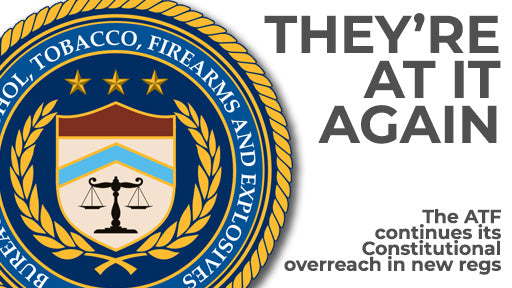
ATF Does it Again
As ardent 2nd amendment supporters, we are deeply troubled by the recent announcement from the ATF regarding their new rule on "Factoring Criteria for Firearms with Attached 'Stabilizing Braces'." This rule, which amends ATF’s regulations to clarify when a rifle is designed, made, and intended to be fired from the shoulder, is a blatant violation of our constitutional rights as protected under the Second Amendment and an infringement on the rights of law-abiding citizens to own and use firearms for self-defense and sport.
Before diving into the details of the new rule, it's important to understand the background and context of this issue. A pistol brace, also known as a stabilizing brace, is a device that attaches to the rear of a pistol, providing a surface for the shooter to rest their arm on. The intent of the device is to provide added stability while firing the pistol, making it easier to control and shoot accurately. It is different from a buttstock, which is designed to be shouldered and fired like a rifle. The demographic of shooters that would find the most benefit from these designs would include shooters with disabilities, younger or female shooters that otherwise would have found it difficult to stabilize certain pistols at their strength level.
One of the most popular firearms that utilizes a pistol brace is the AR pistol. An AR pistol is a type of firearm that uses the same lower receiver as an AR-15 rifle, but with a shorter barrel and no buttstock. It is designed to be fired with one hand, or supported by the non-firing hand. An SBR, or short-barreled rifle, is a rifle with a barrel shorter than 16 inches, and it is regulated under the National Firearms Act (NFA) and requires a special tax stamp and registration with the ATF.
In the past, the ATF has issued several rulings on the use of pistol braces, and their position has been inconsistent. In 2012, the ATF issued a letter stating that a pistol brace could not be used as a shoulder stock, and the firearm would be considered a SBR. However, in 2015, the ATF issued another letter stating that a pistol brace could be used as a shoulder stock, but the firearm would not be considered a SBR, as long as the brace was not re-configured to be used as a stock. This new rule, however, completely changes the ATF's position, stating that a firearm equipped with a stabilizing brace is considered a SBR, regardless of how it is used.
Under this new rule, anyone who owns a firearm with a stabilizing brace that is not registered as an SBR, will be required to register the firearm on an e-Form 1 within 120 days from the date of publication of the final rule in the Federal Register. If the individual does not register the firearm, they will be in violation of the National Firearms Act and could face severe penalties, including fines and imprisonment. Additionally, unlicensed possessors will have several options for compliance, including replacing the short barrel with a barrel that is longer than 16 inches, removing the brace so that it cannot be reattached, forfeiting the firearm to the local ATF office, destroying the firearm, or registering the firearm on an e-Form 1 during 120 days prior to compliance date.
The problem with this new rule is that it is overly broad and subjective, leaving law-abiding citizens at the mercy of the ATF's interpretation of what constitutes a "rifle" or "short-barreled rifle." This opens the door for arbitrary and capricious enforcement, putting law-abiding citizens at risk of criminal prosecution for simply owning a firearm with a stabilizing brace. This not only violates the Second Amendment, but also the due process clause of the Fifth and Fourteenth Amendments. The due process clause ensures that the government cannot take away a citizen's rights without a fair and just process, and this new rule from the ATF does not provide that.
Furthermore, the rule puts undue burden on law-abiding citizens by forcing them to register their firearms with the ATF within 120 days or face severe penalties, including forfeiture of their firearms. This not only violates the Second Amendment, but also the Fifth Amendment's protection against self-incrimination and the due process clause of the Fifth and Fourteenth Amendments. The Fifth Amendment's protection against self-incrimination ensures that citizens cannot be forced to incriminate themselves, and by forcing citizens to register their firearms with the ATF, they are essentially incriminating themselves.
Additionally, the rule's exemption for "stabilizing braces" that are objectively designed and intended as a "stabilizing brace" for use by individuals with disabilities is a clear violation of the Americans with Disabilities Act, which prohibits discrimination against individuals with disabilities. This exemption not only violates the rights of disabled individuals, but it also creates a two-tiered system where disabled individuals are treated differently than able-bodied individuals.
In conclusion, this new rule from the ATF is a violation of our constitutional rights and an infringement on the rights of law-abiding citizens. It opens the door for arbitrary and capricious enforcement, puts undue burden on law-abiding citizens, and violates the rights of disabled individuals. We call on Congress to take immediate action to repeal this unconstitutional rule and protect the rights of law-abiding citizens to own and use firearms for self-defense and sport. As responsible gun owners, we must stand together and let our voices be heard, we must not let our rights be trampled upon by the government.



Leave a comment
This site is protected by hCaptcha and the hCaptcha Privacy Policy and Terms of Service apply.